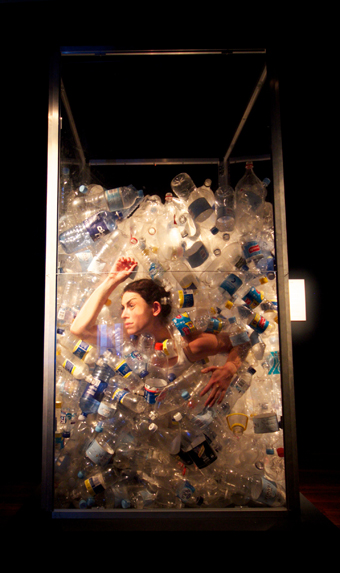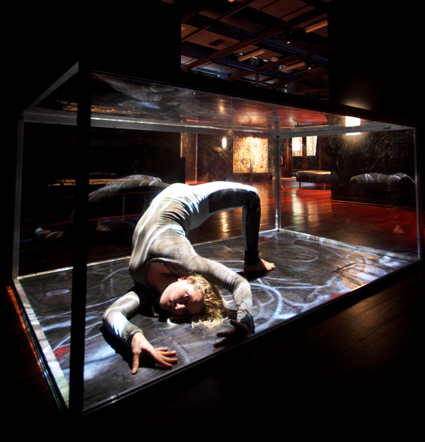 |
Deborah Robertson, Accidental Monsters of Meaning photo Jarrad Seng |
Instead of the horrified delight of my first viewing of these ‘accidental monsters’ too close-up, amidst a small pressed crowd in the now condemned visual art space, Spectrum, the specimens of human bondage in their own wasteful behaviours were now tactfully arranged, beautified by spatial expansiveness and subdued lighting. Ironically, giving equivalent treatment to the rest of the exhibits failed to extend the visceral potency of these danced monsters. In line with their inanimate companions, the metaphorical blood and weeping gristle of the danced specimens were cleansed, spruced up for visual clarity.
The impact of Aimee Smith’s conception lies primarily in the spectator’s shocked recognition of the future, indelibly hatched in the human present. Encased in choreographed taxidermy and animated by innovative technology, the creatures strain in various ways within their bleak destinies. A body ‘drowning’ in a receptacle jam-packed with empty water bottles, speaks of the absurdity of our behaviour. The plastic agitation of the soundscape as a hand penetrates entrapment, mixes humour and desperation with equal and colliding effectiveness. In the Spectrum space, the hand scratching the glass carried the horrendous potential of penetrating the audience’s own skin. Here, the absurd concept remained: but its unsettling proximity was alleviated.
Rhiannon Newton’s caged beast, the once robust and insatiable human consumer, lay trapped in lassitude with flickering enticements for Vegemite and pizza projected across her hunching form, driven deep like irascible tattoos. With the venue’s distancing from the beast, spectator voyeurism seemed less likely to be caught in a hall of mirrors’ effect, watching-the-self-watching-the-self ad infinitum. Moreover, while the zoological inferences are not missed, they are ameliorated—tamed, in a strange way. This species at the edge of extinction suggests an intellectual exercise, at a remove from the confrontational recognition that the caged creature is the human present about to become its future.
In an adjacent enclave, Natalie Holmwood’s Sisyphus amassed boxed products, undeterred in rebuilding an ever-collapsing accumulation of excess. She also hoards communication, strings of incomplete messages winding up and down over the purposeless reconstruction: these two broken actions keep a disconnected rhythm.
 |
Accidental Monsters of Meaning photo Jarrad Seng |
These two specimens filled out the space but did they contribute to the self-inflicted extinction highlighted in the Spectrum configuration? There was also a sequential performance element in the original cramped presentation, wherein each exhibit’s greed was pitched onto and against its neighbours’, which contributed to the claustrophobic perspective. Implication, not just as spectators but as participants in present consumption leading to future collapse, was inescapable.
Enabling spectators to roam freely and democratically bears its own advantages, a conspicuous one being access by the general public and notably the school groups mentioned above. Smith’s political commitment to the persuasive attributes of performance is undeniable, as is the commendable gain of prestige and exposure granted by the museum venue. However loss might ensue, particularly if the other monsters in the equation, the spectators, are given hushed spaces in which to hide. The accidental meanings provoked in an unconducive space may, under the banner of protest, ironically be the best place to be.
Accidental Monsters of Meaning, concept, choreography Aimee Smith, performers Deborah Robertson, Rhiannon Newton, Bianca Martin, Aisling Donovan, Natalie Holmwood, Isabella Stone, sound design Ben Taaffe, costume design Esther Gauntlett, Jason Reibel, projections Aimee Smith, Chris Jordan, Western Australian Museum, Perth, March 26-April 3.
RealTime issue #103 June-July 2011 pg. 30
© Maggi Phillips; for permission to reproduce apply to [email protected]








 back
back